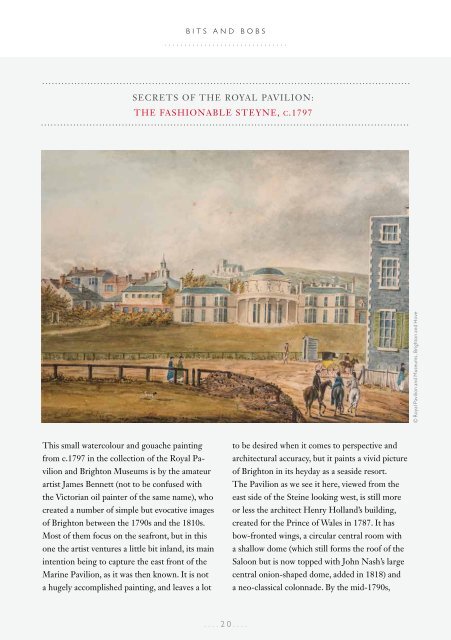Viva Brighton Issue #45 November 2016
You also want an ePaper? Increase the reach of your titles
YUMPU automatically turns print PDFs into web optimized ePapers that Google loves.
BITS AND BOBS<br />
...............................<br />
SECRETS OF THE ROYAL PAVILION:<br />
THE FASHIONABLE STEYNE, C.1797<br />
© Royal Pavilion and Museums, <strong>Brighton</strong> and Hove<br />
This small watercolour and gouache painting<br />
from c.1797 in the collection of the Royal Pavilion<br />
and <strong>Brighton</strong> Museums is by the amateur<br />
artist James Bennett (not to be confused with<br />
the Victorian oil painter of the same name), who<br />
created a number of simple but evocative images<br />
of <strong>Brighton</strong> between the 1790s and the 1810s.<br />
Most of them focus on the seafront, but in this<br />
one the artist ventures a little bit inland, its main<br />
intention being to capture the east front of the<br />
Marine Pavilion, as it was then known. It is not<br />
a hugely accomplished painting, and leaves a lot<br />
to be desired when it comes to perspective and<br />
architectural accuracy, but it paints a vivid picture<br />
of <strong>Brighton</strong> in its heyday as a seaside resort.<br />
The Pavilion as we see it here, viewed from the<br />
east side of the Steine looking west, is still more<br />
or less the architect Henry Holland’s building,<br />
created for the Prince of Wales in 1787. It has<br />
bow-fronted wings, a circular central room with<br />
a shallow dome (which still forms the roof of the<br />
Saloon but is now topped with John Nash’s large<br />
central onion-shaped dome, added in 1818) and<br />
a neo-classical colonnade. By the mid-1790s,<br />
....20....


















